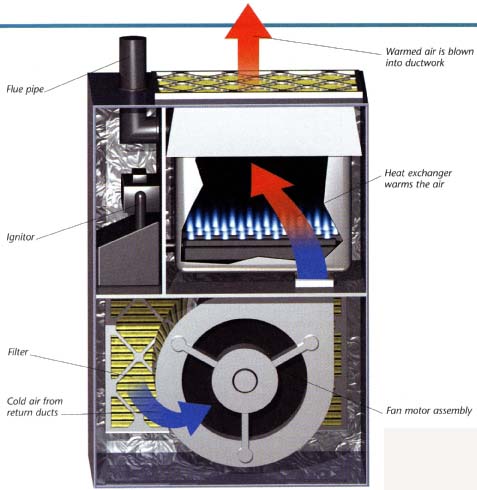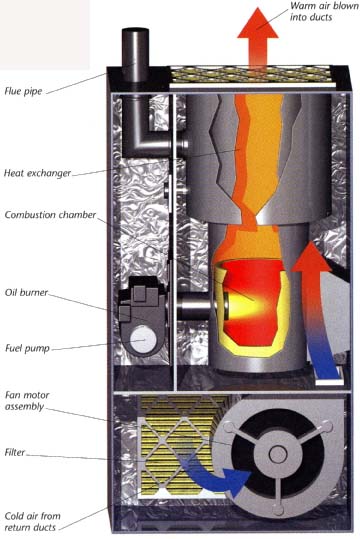Your furnace is the most important component of your central heating system so take care to maintain it properly. Think carefully if you are replacing an old furnace. Choose the type of furnace that is compatible to your climate, your house, and your lifestyle. When you select a furnace from the many options available, you are affecting the quality and cost of your heating for the life of your house. As discussed on the previous page, a forced-air system is the most common type heating powered by a furnace. Discussed here are both oil- and gas-fueled options.
HOW FURNACES WORK
If room temperature drops below your thermostat’s setting, it signals to the furnace’s controls to start the burner. Air is drawn into the furnace through a filter, where dust and other small particles are trapped. A blower unit blows the filtered air through the furnace, where the air absorbs heat. The warm air is then forced through a system of air ducts to each room in your home until the thermostat setting is reached. No matter the type of furnace you choose, plan for regular maintenance. Make sure the system is efficient, and that your home’s heating system continues to be safe.
Heating codes
Heating is a regulated part of a home’s construction.
There are local codes that dictate almost every aspect of residential heating, which include ducting, location, and the type of fuel systems allowed. Most jurisdictions follow similar guidelines. Some typical guidelines may include the following:
- Forced air furnaces must have a control limit that prevents the air in the outlet from exceeding 250 F (120-degrees C)
- Heating equipment must have a power outlet within 25 ft (7.5 m) of the unit Fuel burning furnaces cannot be installed in storage rooms
- Metal ducts must have a clearance to the ground of at least 6 ft (2 m)
- Gas lines cannot pass through walls
- Room heaters need 18 in (45 cm) of working space
Gas furnaces
Forced air from a gas furnace is a common heating system. Centrally located in a house, the furnace burns either natural or propane gas. Indoor air flows around the heat exchanger, is heated, and then circulated throughout the house through ductwork. Other ducts return air to the furnace to be reheated and re-circulated. Additional air is drawn into the flue for venting purposes. This air mixes with the hot exhaust gases and exits through the chimney.
There are three types of gas furnaces: a conventional warm-air furnace, an induced draft furnace, and a condensing furnace. Conventional furnaces draw air through an opening in their front, and through the flue, to create a natural draft. Induced draft furnaces use a fan to draw the combustion products into the flue for increased efficiency. A condensing furnace contains a second heat exchanger that condenses water vapor in the hot flue gases, thereby extracting additional heat. Condensing furnaces are among the most efficient on the market.
Oil furnaces
Oil furnaces use fuel oil burned in a sealed chamber to create heat for a home. A fan or blower helps to force this heat across an exchanger, and then into the ductwork of the house. Oil-based furnaces can last more than 10 years. In order to reap the benefits of an oil system, the furnace requires regular maintenance. Make sure you replace the filter each month. Ask a professional to check the burner, heat exchanger, pipe, and the fuel-to-air mixture adjustment annually.
Electric heat
Some furnaces are powered by electricity. The electric current travels through a heating element, which warms air passing over it. The heated air rises into the ductwork, and into the house. The process of the heat transfer is called conduction and convection.
Energy efficiency
If you are considering replacing a furnace, look for the Energy Star label. If you purchase certain types of Energy Star products, you can quality for a tax credit. Tax credits are available for products that are rated at the highest efficiency levels. While these products have a higher initial cost, they do tend to save operational costs over the life of the product with lower energy bills.
Energy Star qualified furnaces have an annual fuel utilization efficiency (AFUE) rating of 90% or greater, which makes them about 15 percent more efficient than standard models. By choosing Energy Star, you are not only helping reduce your energy costs, you are also helping promote cleaner air while enhancing your home.
FIND A CONTRACTOR
It is crucial to find the right contractor to install and repair your system to ensure it is safe and efficient. Professionals not only know how to install heating systems, they will also specify the correct size and design. If you do not have a trusted referral from a friend, try the Air Conditioning Contractors of America (ACCA). This non-profit association organization has an online Contractor Locator so you can find the best Heating, Ventilation, Air- conditioning and Refrigeration (HVACR) contractor near your home. The website www.acca.org also includes contractors who sell and are knowledgeable about ENERGY STAR qualified HVAC equipment. Even though ACCA contractors are knowledgeable about ENERGY STAR, they are not endorsed by the U.S. EPA.
WORKING SAFETY
All new furnaces must comply with code and safety issues, and any failure or malfunction that allows gas or combustion fumes into the vent portion will automatically shut down the furnace. However, as an extra safety backup you should always install a carbon monoxide (CO) detector alongside your furnace for your family’s safety.
Gas furnace
Natural or propane gas can be used as fuels for furnaces, depending on what is available from your power company. The furnace usually includes an ignitor, fan, heat exchanger, filter, and flue pipe. Gas that feeds into the furnace from the gas line is burned in a sealed unit and moved into a heat exchanger. The air blower (fan motor) moves the air into the ductwork of the home where the warm air is released into each room. Cool air flows back into the furnace from return ducts through filters to remove any particulates. It is then heated before flowing back through the supply vents into the room. Never work on a gas furnace yourself. Always hire a professional when your gas furnace needs repair. You can maintain the filters yourself—check them and replace when necessary. Having a clean filter helps improve the efficiency of your furnace and reduces energy costs.
Oil furnace
You will need an oil storage tank and a yearly delivery of fuel oil to power an oil furnace. Usually your oil provider will check your system at the same time to make sure it is functioning properly. As shown to the right, the basic elements of the oil furnace are similar to the gas furnace. Both have filters, a fan motor, flue pipe, and a heat exchanger. The difference between the two is how the air is heated inside the unit. Using an oil burner, the oil is converted into a spray. Air is mixed in with this spray, which ignites the mixture, heating it up. The blower then moves this air through the space and into the ductwork, which transports it to each room of your home. A thermostat switches the furnace on and off to keep the house at the desired temperature.
FURTHER INFORMATION
Even if you have the best and most efficient furnace money can buy, you may still not be reaping all o the energy benefits possible. A fundamental part of your heating and cooling system is having a well-insulated home. More than 65% of all US households have under-insulated homes, according to the Harvard University School of Public Health. If your home is between 5 and 10 years old, you are likely to live in one of those 46 million homes. See this page on how to improve the insulation in your home.
Previous: Thermostats and Controls | Next: Heat Pumps

